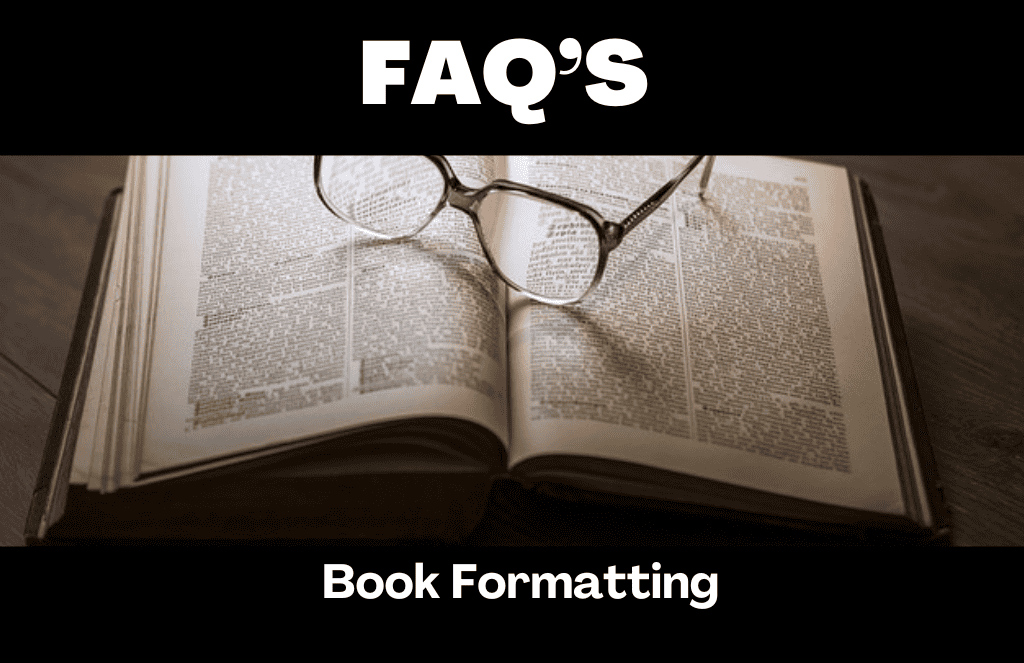Tag Archives for " why is book formatting important "
Book Formatting

What is Book Formatting: Mastering the Art of Presentation
Book formatting involves the organization and structuring of a book’s content, such as margins, fonts, spacing, and placement of images and text, to ensure a visually appealing and coherent final product. In addition to enhancing the overall look and feel of the book, proper formatting is essential for readability and understanding for the reader.
It also plays a crucial role in publishing, as different platforms and devices require specific formatting standards. By following these guidelines, authors and publishers can create books that are professional, engaging, and optimized for different reading experiences.
How To Define Book Formatting?
Book formatting refers to the process of structuring and presenting the contents of a book in a visually appealing manner. It involves arranging the text, headings, paragraphs, images, and other elements to create a coherent and aesthetically pleasing layout.
Formatting ensures that the book is easy to read, visually appealing, and engages the reader.
It includes various aspects such as:
- Page layout
- Font selection
- Text alignment
- Paragraph spacing
- Chapter headings
- Page numbering
- Headers and footers
By paying attention to these details, book formatting creates a harmonious visual experience for the reader, making the book more enjoyable to read.
Importance Of Book Formatting
Proper book formatting is essential for various reasons:
Reader Experience: A well-formatted book enhances the reader’s experience by making it easy to navigate through the content. Clear headings, consistent font sizes, and proper spacing between paragraphs contribute to a smooth reading experience.
Professionalism: Professional formatting gives a book a polished and finished look. It conveys that the author has taken the time and effort to present their work in the best possible way, increasing the perceived value of the book.
Readability: Proper formatting ensures that the text is easy to read. Choosing an appropriate font size, line spacing, and paragraph alignment aids in readability and reduces the strain on the reader’s eyes.
Compatibility: Book formatting ensures that the content is compatible with various reading devices and platforms. This is particularly important in the age of e-books and digital publishing, where readers may access books on different devices.
Organization: By properly structuring the content, book formatting enables effective organization. Clear chapter headings, subheadings, and page breaks improve the flow of information and help readers locate specific sections easily.
Accessibility: Formatting plays a crucial role in making a book accessible to a wider audience, including individuals with visual impairments. Implementing appropriate formatting techniques can make the content more accessible through audio readers or digital text-to-speech technology.
Overall, book formatting is a critical step that cannot be overlooked. It not only enhances the reader’s experience but also reflects the professionalism and commitment of the author. By investing time and effort into formatting, authors can elevate their work and increase its chances of resonating with readers.
Elements Of Book Formatting
When it comes to creating a professional and visually appealing book, proper formatting is essential. Book formatting involves the arrangement and presentation of various elements within a book to ensure a consistent and cohesive design. By paying attention to the elements of book formatting, authors and publishers can create a visually pleasing reading experience for their audience.
Page Layout And Margins
Page layout and margins play a crucial role in book formatting. How content is positioned on a page can impact the overall aesthetic and readability of a book. By setting appropriate margins, authors and publishers can ensure that the text is comfortably centered within the page, allowing readers to focus on the content without feeling overwhelmed.
Moreover, a well-considered page layout helps create a sense of balance, making it easier for readers to follow along.
Typography And Font Choice
The choice of typography and fonts can greatly influence the readability and visual appeal of a book. It is important to select a font that is easy to read and suits the genre and theme of the book. Whether it is a serif, sans-serif, or decorative font, consistency is key.
By consistently using the same typography and font throughout the book, authors and publishers can maintain a cohesive and professional look.
Headers, Footers, And Page Numbers
Headers, footers, and page numbers serve as navigational aids for readers. Headers often include chapter titles or author names, while footers commonly display page numbers and other relevant information.
Chapter Headings And Subheadings
Chapter headings and subheadings help organize the content within a book, allowing readers to navigate and comprehend the material more effectively.
Consistent formatting of chapter headings and subheadings not only enhances the visual appeal of a book but also aids in the readability and overall flow of the content.
Images, Tables, And Graphs
Visual elements such as images, tables, and graphs can enhance the overall reading experience and illustrate complex concepts or data. Proper formatting ensures that these elements are appropriately placed within the text, with consistent alignment, captions, and references. By integrating visual components seamlessly, authors and publishers can engage readers and convey information effectively.
Consistency And Alignment
Consistency and alignment are essential aspects of book formatting. Consistent formatting throughout a book creates a sense of professionalism and helps readers navigate the content effortlessly.

Mastering The Art Of Presentation
When it comes to books, it’s not just about the captivating story or the insightful information in the pages. The visual presentation plays a crucial role in grabbing readers’ attention and creating a lasting impression.
Book formatting is an essential aspect of the presentation process, ensuring that every element is carefully arranged to create a visually appealing and reader-friendly experience.
Proper Text Formatting
Proper text formatting is vital for enhancing readability and making your content more engaging. When formatting your book, pay attention to the following aspects:
Font selection: Choose a legible font style, such as Arial or Times New Roman, that is easy on the eyes.
Font size: Opt for a font size that is comfortable to read, typically between 10 to 12 points for body text.
Line spacing: Ensure sufficient line spacing to prevent the text from feeling too cramped. A line spacing of 1.5 or 2 can be ideal.
Paragraph indentation: Use paragraph indentation to provide visual cues that distinguish between paragraphs, making it easier for readers to follow along.
Effective Use Of White Space
White space, also known as negative space, refers to the empty space surrounding the text and images in your book. Utilizing white space effectively is crucial for maintaining a clean and organized layout. Consider the following tips:
- Margin size: Set appropriate margins to create sufficient white space around the edges of each page.
- Line spacing: Proper line spacing not only aids readability but also helps in incorporating white space within the text itself.
- Chapter breaks: Use ample white space to signal chapter breaks, allowing readers to pause and mentally prepare for the upcoming content.
- Section headings: Provide generous spacing before and after section headings to enhance their visibility and create a visual hierarchy.
Choosing The Right Book Binding
Book binding not only ensures that all the pages remain together, but it also contributes to the book’s overall aesthetic appeal. Here are some binding options to consider:
| Option | Description |
| Saddle Stitch | A cost-effective and popular method for booklets or magazines with fewer pages. |
| Perfect Binding | Ideal for books with a higher page count, offering a professional and durable finish. |
| Hardcover Binding | Provides a premium look and feel, suitable for books that will be treasured for years to come. |
Cover Design And Layout
The cover is the first thing readers see, and it plays a significant role in attracting their attention. Consider these factors when designing your book cover:
- Title and author name: Make sure these key elements are easily readable and visually appealing.
- Images and graphics: Choose eye-catching images or graphics that align with the book’s genre or content.
- Layout composition: Plan a balanced layout that arranges the elements harmoniously, ensuring a visually pleasing and professional result.
- Color scheme: Select a color scheme that complements the genre and evokes the desired emotions.
Frequently Asked Questions On What Is Book Formatting

What Is Book Formatting And Why Is It Important?
Book formatting refers to the layout and design of a printed or digital book. It includes elements such as font styles, chapter headings, margins, and page numbers. Having proper formatting is crucial as it enhances readability, professionalism, and overall user experience.
Without proper formatting, the book may look unappealing and be difficult to read.
What Are The Key Elements Of Book Formatting?
Key elements of book formatting include font selection, line spacing, page margins, use of headers and footers, paragraph indentation, chapter and section headings, and proper placement of images and graphics. These elements help ensure that the book is visually appealing, organized, and easy to navigate for readers.
Should I Hire A Professional For Book Formatting?
Hiring a professional for book formatting can be a wise decision. Professionals have the expertise to ensure your book is formatted correctly and in line with industry standards. They can handle technical details, such as formatting for different types of devices and platforms.
Additionally, professionals can save you time and ensure that your book looks polished and professional.
Can I Format My Book Myself Without Any Prior Experience?
Formatting your book yourself is possible but can be challenging, especially if you have no prior experience. It requires knowledge of formatting guidelines, software skills, and attention to detail. If you are willing to invest time in learning and practicing, you may be able to format your book yourself.
However, if you want a professional and polished result, it is advisable to hire a professional formatter.
Conclusion
Book formatting is an essential element in the publishing process, ensuring that the layout, structure, and design of a book are aesthetically pleasing and reader-friendly. It plays a crucial role in enhancing the overall reading experience by ensuring consistency in fonts, spacing, margins, and page numbering.
Share